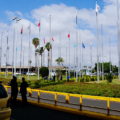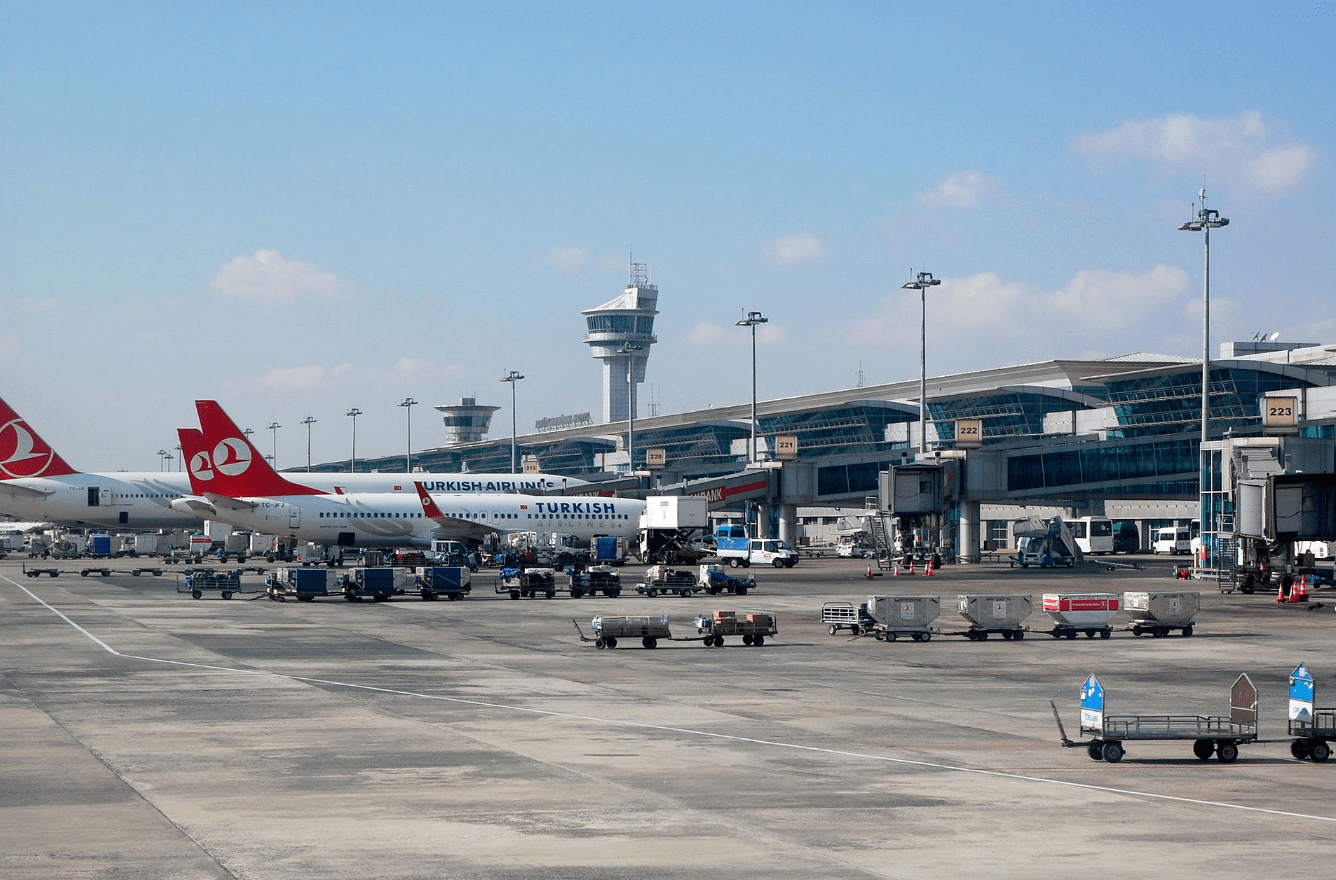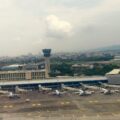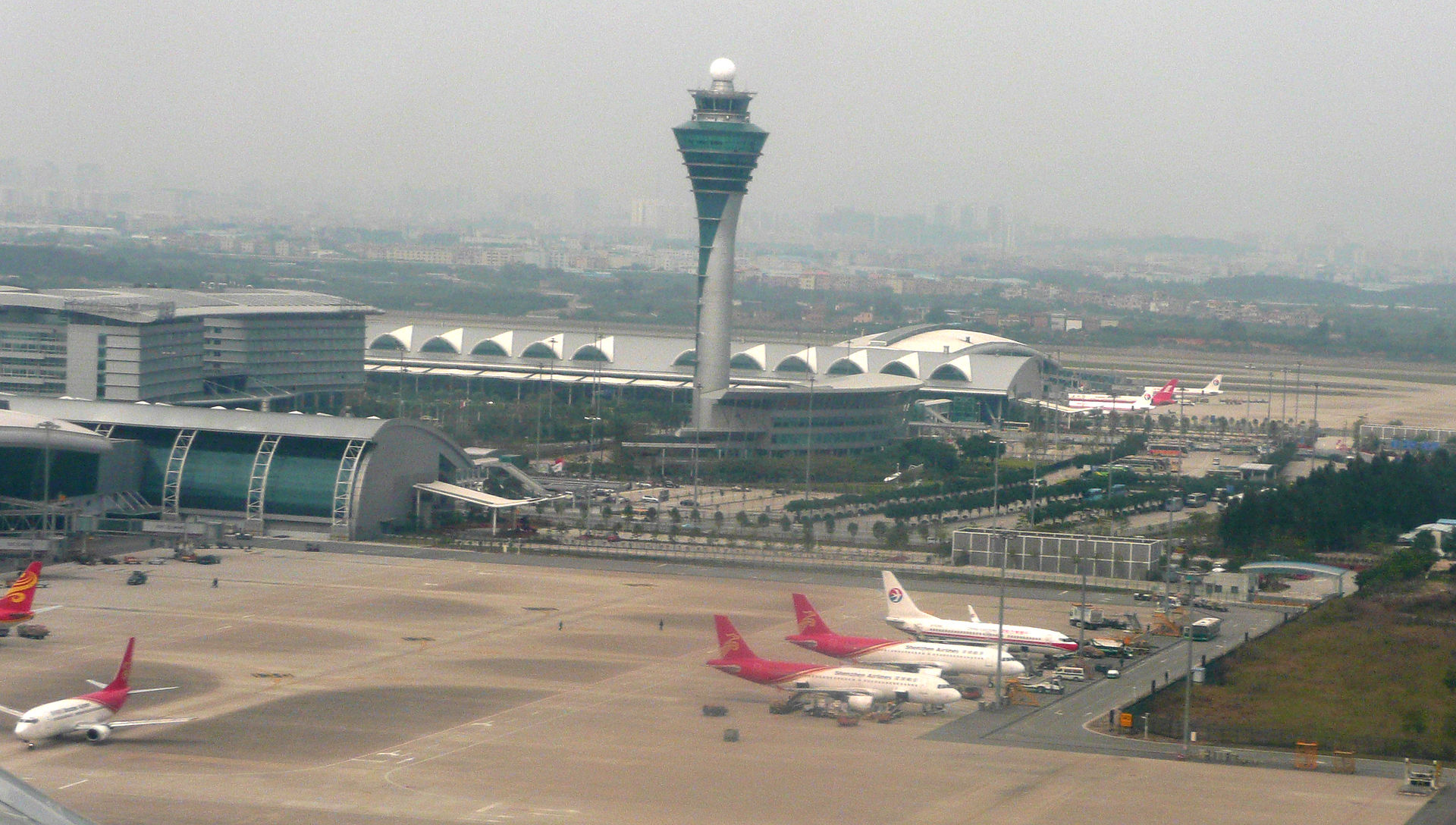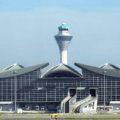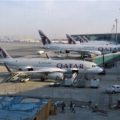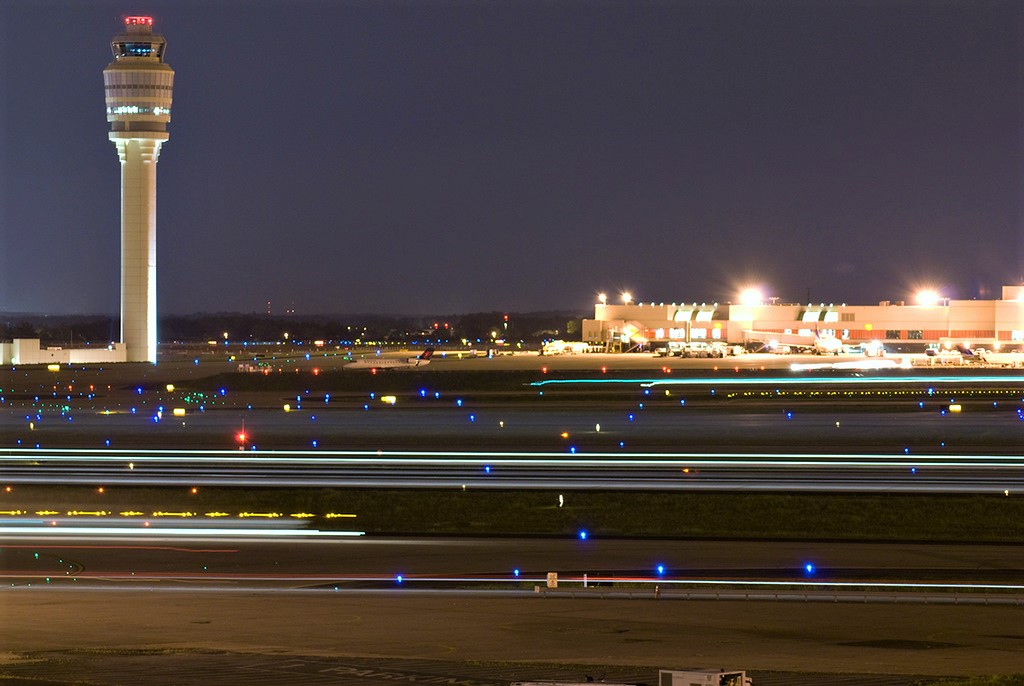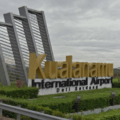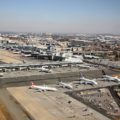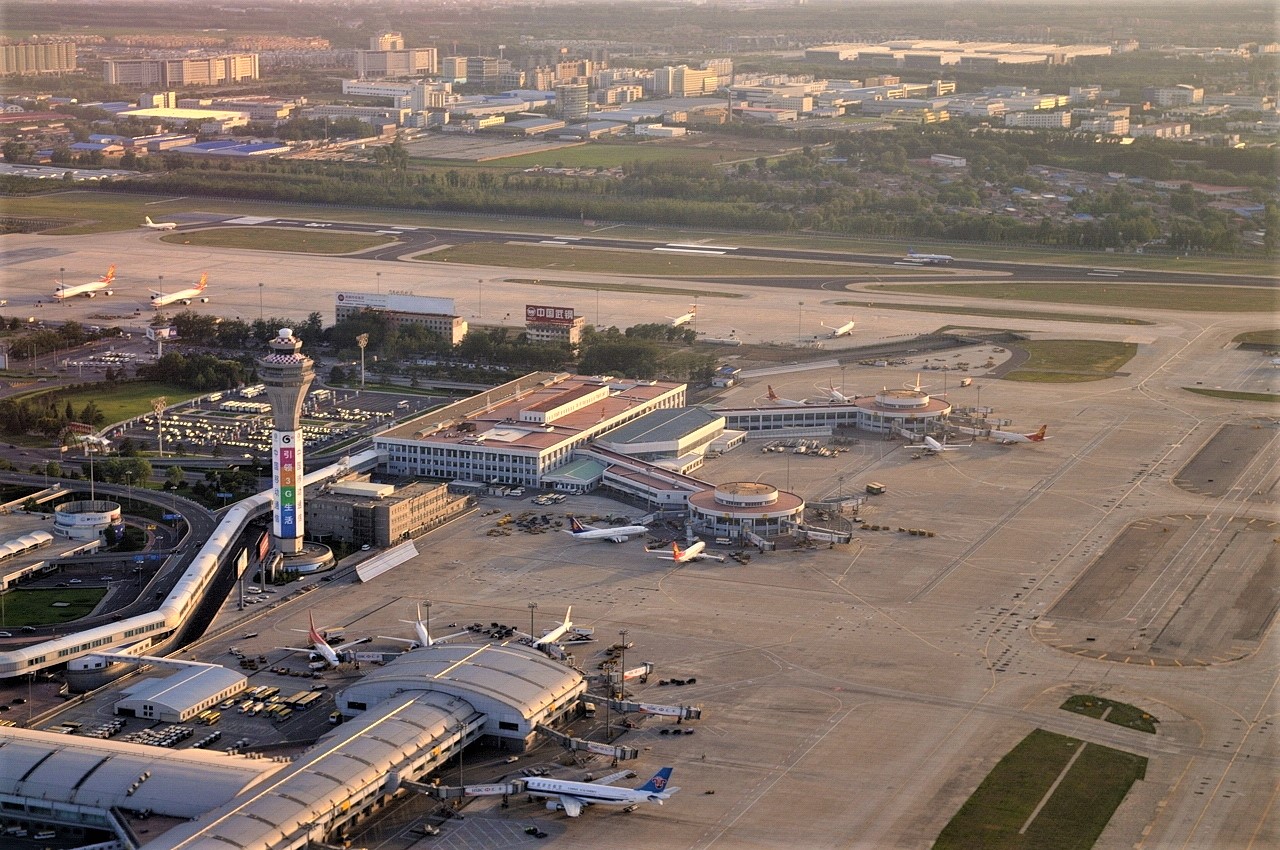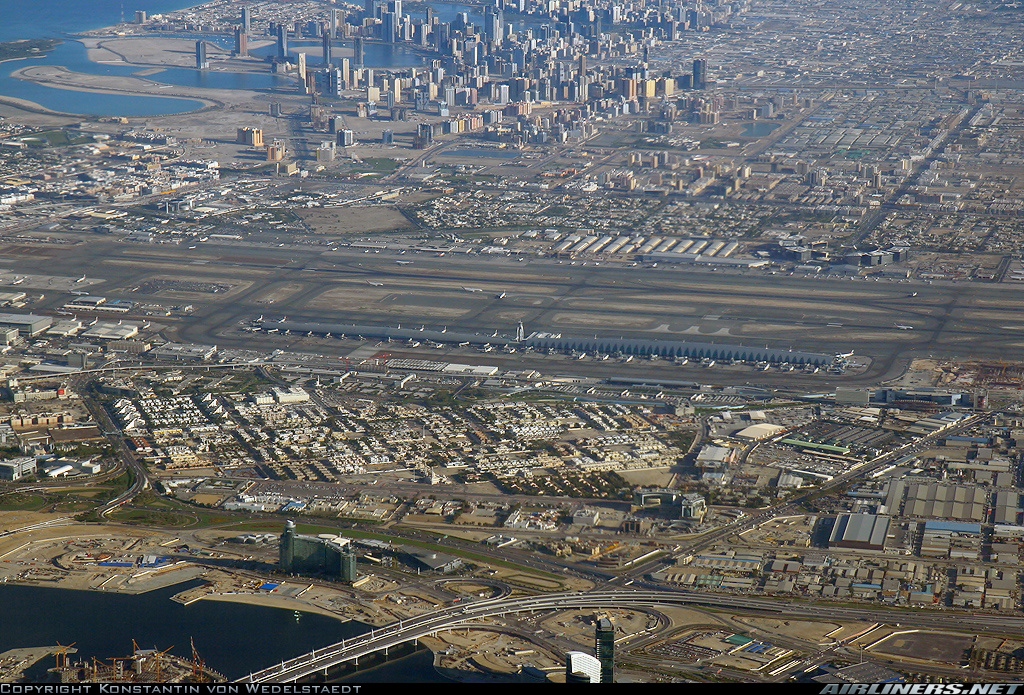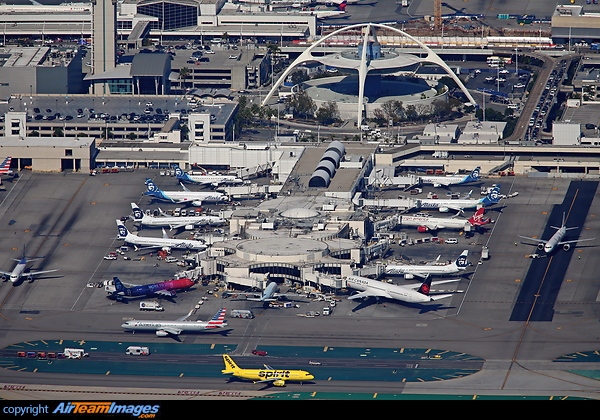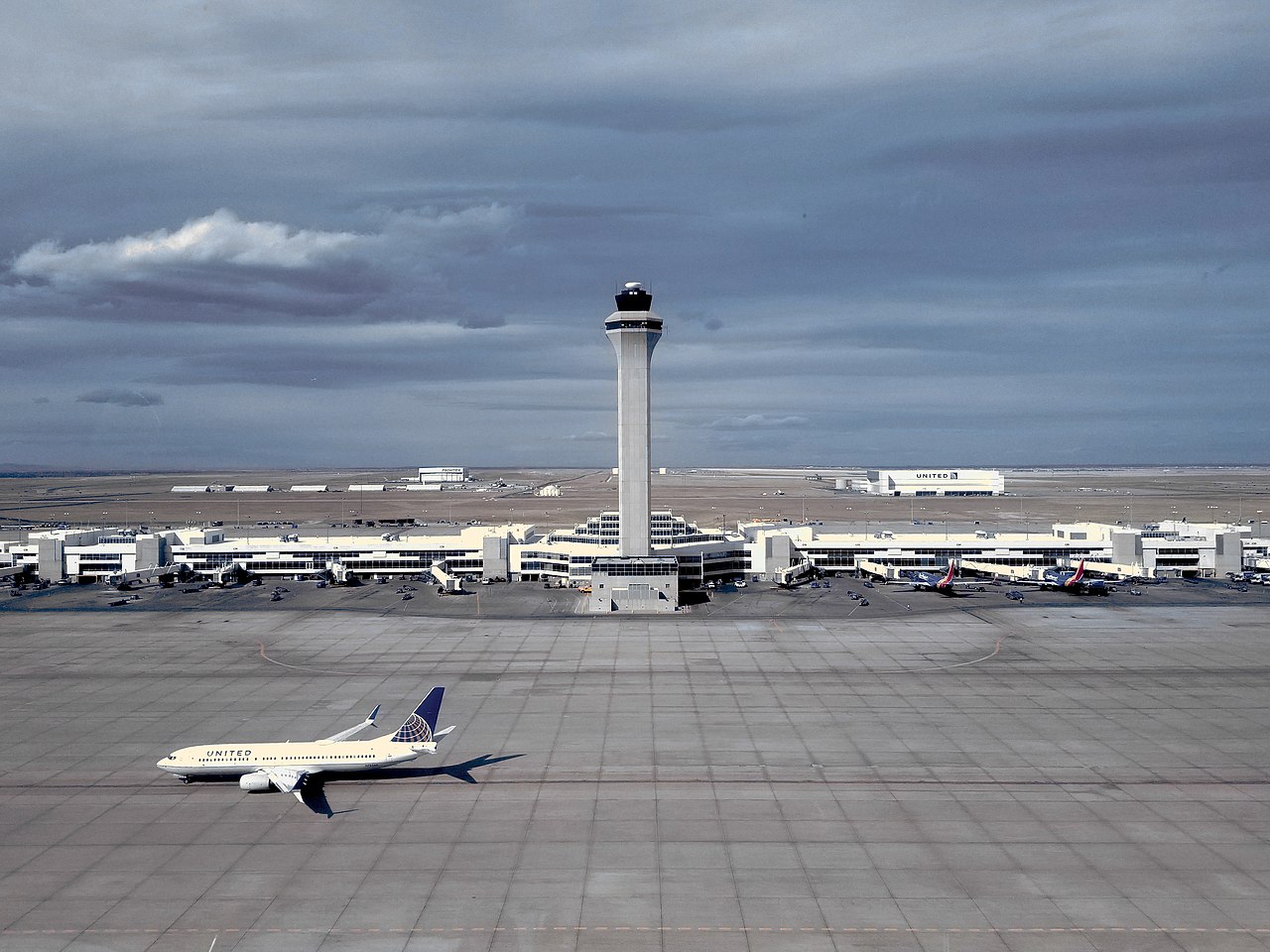Aviation
Delhi Indira Gandhi International Airport
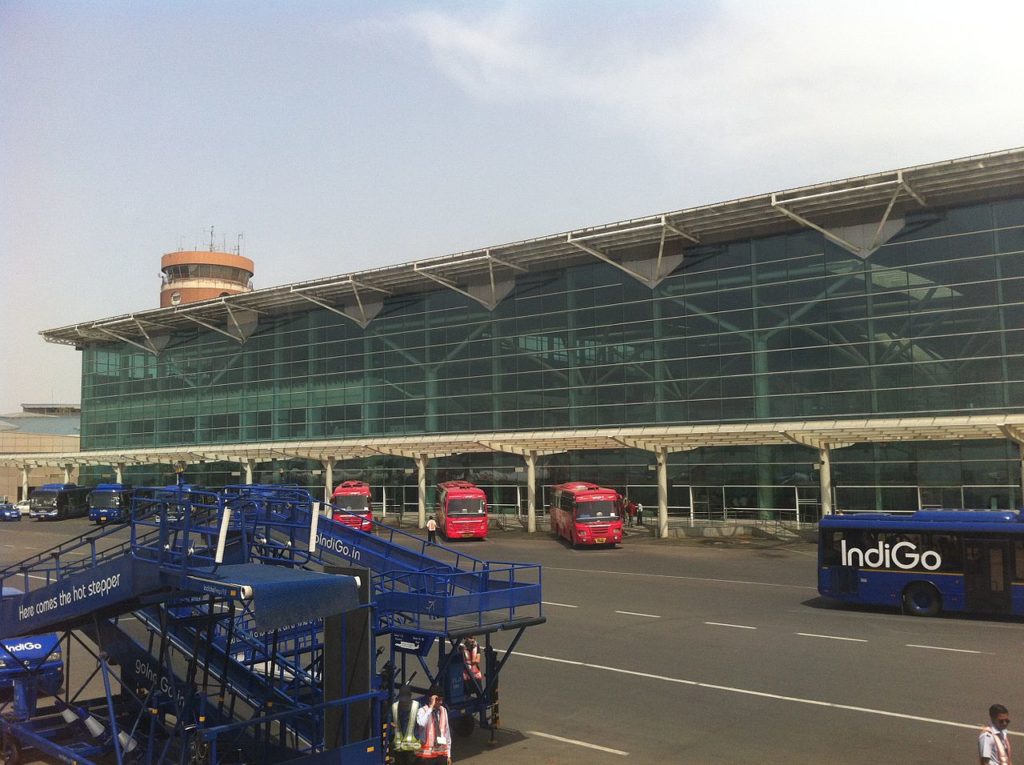
Source: Akash Bhairav Gupta
| IATA: DEL ICAO: VIDP | |
| Airport type | Public |
| Owner | Delhi International Airport Pvt Ltd (DIAL) (64%) Airports Authority of India (26%) Fraport (10%) |
| Operator | Delhi International Airport Pvt Ltd (DIAL) |
| Serves | Delhi/ NCR |
| Location | Palam, Delhi, India |
| Hub for | Air India AirAsia India Alliance Air GoAir IndiGo Quikjet Airlines SpiceJet Vistara Zoom Air |
| Elevation AMSL | 237 m / 777 ft |
| Coordinates | |
| Website | Delhi Airport |
Indira Gandhi International Airport (IATA: DEL, ICAO: VIDP) serves as the major international aviation hub of the Indian capital city of New Delhi as well as India. The airport, spread over an area of 5,106 acres (2,066 ha), is situated in Palam, 15 km (9.3 mi) south-west of the New Delhi railway station and 16 km (9.9 mi) from New Delhi city centre. Named after former Prime Minister of India Indira Gandhi, it is the busiest airport in India in terms of passenger traffic since 2009. It is also the busiest airport in the country in terms of cargo traffic, overtaking Mumbai during late 2015. In the calendar year 2018, it was the 12th busiest airport in the world and 6th busiest airport in Asia by passenger traffic handling nearly 70 million passengers. It is the world’s busiest airport for Airbus A320 aircraft. The under construction expansion program will increase the airport’s capacity to handle 100 million passengers by 2030.
The airport was operated by the Indian Air Force before its management was transferred to the Airports Authority of India In May 2006, the management of the airport was passed over to Delhi International Airport Limited (DIAL), a consortium led by the GMR Group.In September 2008, the airport inaugurated a 4,430 m (14,530 ft) runway. With the commencement of operations at Terminal 3 in 2010, it became India’s and South Asia’s largest aviation hub. The Terminal 3 building has a capacity to handle 34 million passengers annually and is the world’s 8th largest passenger terminal. The airport uses an advanced system called Airport Collaborative Decision Making (A-CDM) to help keep takeoffs and landings timely and predictable.
In 2010, IGIA was conferred the fourth best airport award in the world in the 15–25 million category, and Best Improved Airport in the Asia-Pacific Region by Airports Council International. The airport was rated as the Best airport in the world in the 25–40 million passengers category in 2015, by Airports Council International. Delhi Airport was awarded The Best Airport in Central Asia and Best Airport Staff in Central Asia at the Skytrax World Airport Awards 2015. IGI also stood first in the new rankings for 2015 Airport Service Quality (ASQ) Awards conducted by Airports Council International. The airport, along with Mumbai Airport was adjudged “World’s Best Airport” at Airport Service Quality Awards 2017 in the highest category of airports handling more than 40 million passengers annually.
The other airport serving Delhi NCR is Hindon Airport which is much smaller in size and primarily handles regional flights out of the city under the government’s UDAN. Safdarjung Airport is used mainly by VVIP helicopters and small charter helicopters due to its short runway. Jewar Airport is being planned to offset the load of Indira Gandhi International Airport.
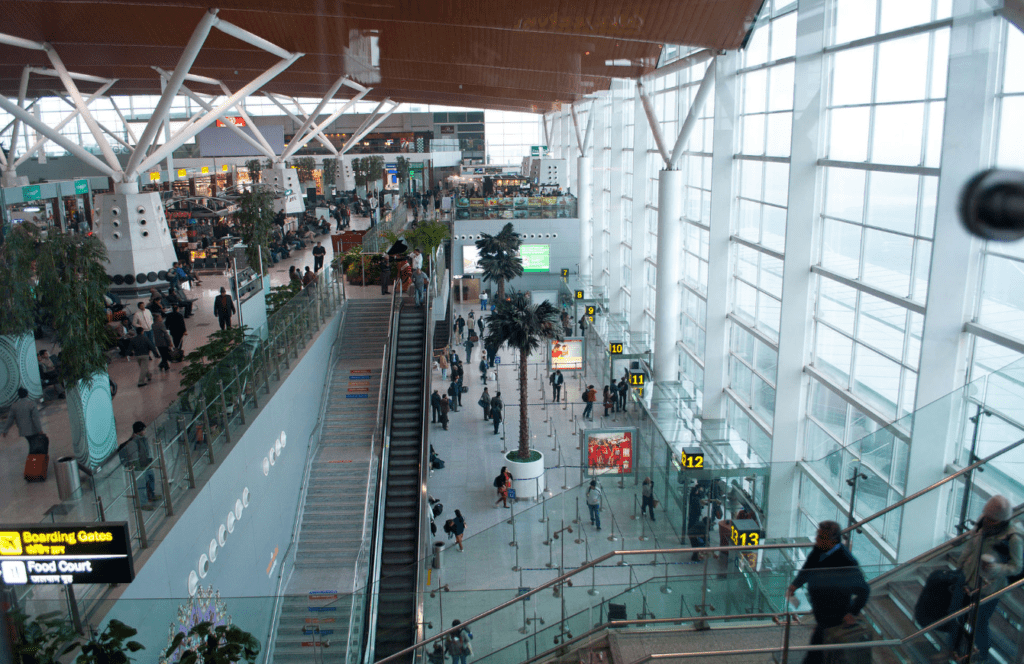

Source: Flickr: Delhi Airport
Facilities
Runways
| 29/11 | 4,430 m (14,530 ft) | 60 m (200 ft) | CAT III-B / CAT III-B |
| 28/10 | 3,810 m (12,500 ft) | 46 m (151 ft) | CAT III-B / CAT I |
| 27/09 | 2,813 m (9,229 ft) | 45 m (148 ft) | CAT I / CAT I |
Delhi Airport has three near-parallel runways: runway 11/29, 4,430 m × 60 m (14,530 ft × 200 ft) with CAT IIIB instrument landing system (ILS) on both sides, runway 10/28, 3,810 m × 46 m (12,500 ft × 151 ft), and runway 09/27, 2,813 m × 45 m (9,229 ft × 148 ft). In addition to Chaudhary Charan Singh International Airport in Lucknow and Jaipur Airport in Jaipur, Delhi Airport is the only airports in India to have been equipped with the CAT III-B ILS. In the winter of 2005, there were a record number of disruptions at Delhi airport due to fog/smog. Since then some domestic airlines have trained their pilots to operate under CAT-II conditions of a minimum 350 m (1,150 ft) visibility. On 31 March 2006, IGI became the first Indian airport to operate two runways simultaneously following a test run involving a SpiceJet plane landing on runway 28 and a Jet Airways plane taking off from runway 27 at the same time.
The initially proposed mode involving simultaneous takeoffs in westerly flow to increase handling traffic capacity caused several near misses over the west side of the airport where the centrelines of runways 10/28 and 9/27 intersect. The runway use was changed to segregate dependent mode on 25 December 2007, which was a few days after the deciding near miss involving an Airbus A330-200 of Qatar Airways and an Indigo A320 aircraft. The new method involved use of runway 28 for all departures and runway 27 for all arrivals. This mode which was more streamlined was adopted during day hours (0600 – 2300 IST) till 24 September 2008.
On 21 August 2008, the airport inaugurated its 3rd runway 11/29 costing ₹10 billion and 4,430 m (14,534 ft) long. The runway has one of the world’s longest paved threshold displacements of 1,460 m (4,790 ft). This, in turn decreases the available landing length on runway 29 to 2,970 m (9,744 ft). The purpose of this large threshold displacement is to reduce noise generated by landing aircraft over nearby localities. The runway increases the airport’s capacity to handle up to 100 flights from the previous 45–60 flights per hour. The new runway was opened for commercial operations on 25 September 2008 and gradually began full round-the-clock operations by the end of October the same year.
Since mid 2012 all three runways are operated simultaneously to handle traffic during day hours. Only runways 11/29 and 10/28 are operated during night (2300–0600 IST) hours with single runway landing restriction during westerly traffic flow that is rotated late night (0300 IST) and reversed weekly to distribute and mitigate night time landing noise over nearby residential areas.
To cater for the demand of increasing air traffic, the master plan for the construction of a fourth parallel runway next to the existing runway 11/29 has been cleared.
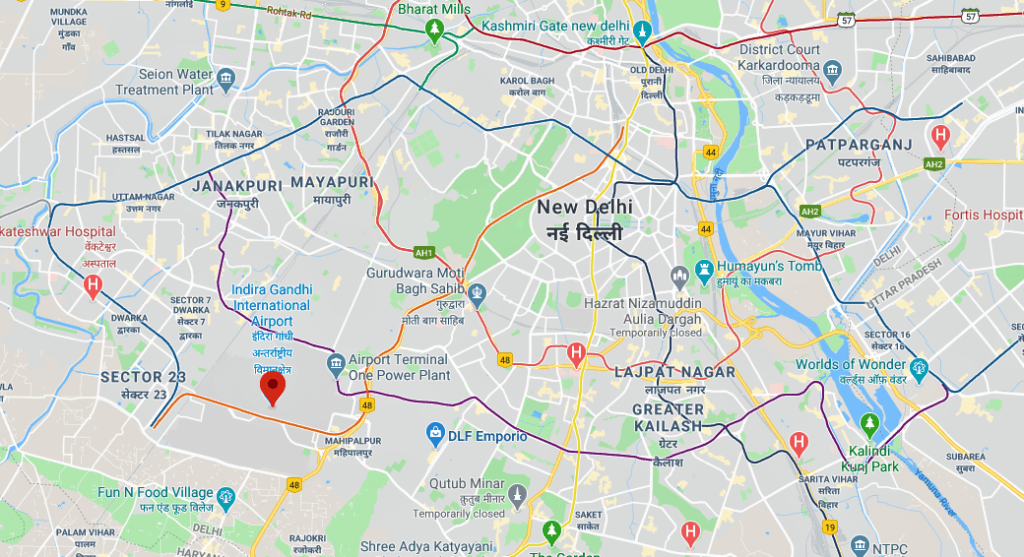

Terminals
IGI Airport serves as a major hub or a focus destination for several Indian carriers including Air India, Air India Regional, IndiGo, SpiceJet, GoAir and Vistara. Approximately 80 airlines serve this airport. At present there are three active scheduled passenger terminals, a dedicated Hajj terminal and a cargo terminal.
Domestic and International Operations
Terminal 3 is used for international flights. The Indian carriers operating international flights (as of 2 October 2019) are Air India, Indigo, SpiceJet, GoAir and Vistara.
As far as domestic operations are concerned, Terminal 3 is used by Air India, AirAsia and Vistara.
GoAir and Indigo use Terminal 2, while SpiceJet uses Terminal 1 and Terminal 3 (temporarily) for their domestic operations.
Terminal 1
Terminal 1 is currently used by low cost carriers IndiGo and SpiceJet. DIAL is working to expand Terminal 1 and enhance its annual passenger handling capacity from the current 18 million to 30 million within four years by 2022.Terminal 1A
Terminal 1A was built in the late 1980s to cater to Indian Airlines. It had to be refurbished after a fire gutted the interiors and DIAL significantly upgraded the terminal. It was used by Air India for its Airbus operations until it shifted to the new Terminal 3 on 11 November 2010. The terminal is now closed and is expected to be torn down on the completion of newer terminals.Terminal 1CInterior of the Domestic Terminal
Terminal 1C is used only for domestic arrivals. The terminal has been upgraded with a new expanded greeting area and a larger luggage reclaim area with eight belts.Terminal 1D
Terminal 1D is the newly built domestic departure terminal with a total floor space of 53,000 m2 (570,000 sq ft) and has a capacity to handle 15 million passengers per year. Terminal 1D commenced operations on 19 April 2009. It has 72 Common Use Terminal Equipment (CUTE) enabled check-in counters, 16 self check-in counters, and 16 security channels.
Terminal 2
Terminal 2 was opened on 1 May 1986, at a cost of ₹950 million and was used for International flights until July 2010 when operations shifted to Terminal 3. After this, the terminal remained operational for only three months per year catering to Hajj flights. In 2017, after revamping Terminal 2 at a cost of ₹1 billion, DIAL shifted operations of GoAir to the terminal from 29 October in order to continue expansion work of T1. Now, GoAir along with SpiceJet and Indigo operates its daily flights from this terminal.
Terminal 3
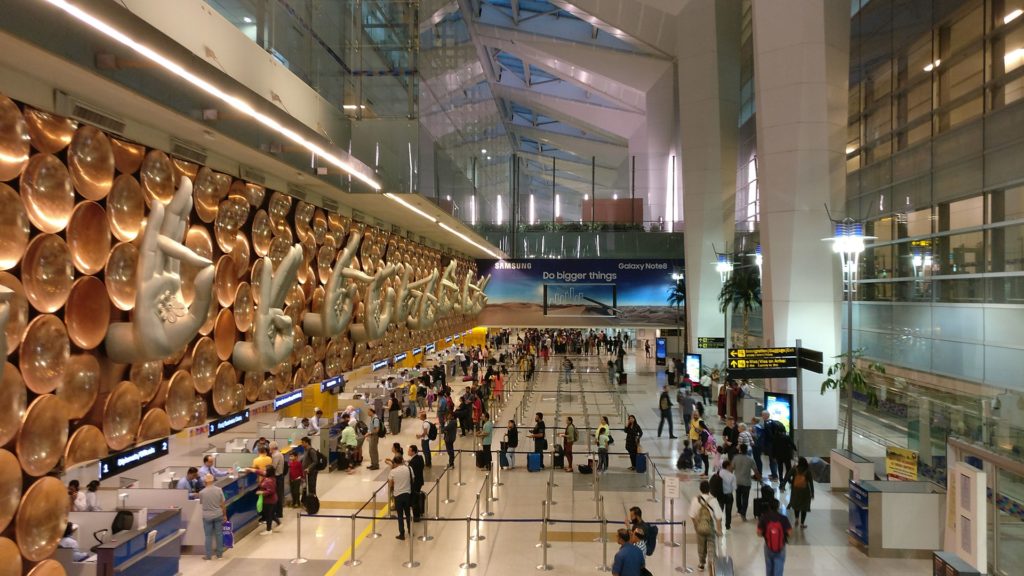

Source: Bharatahs
Designed by HOK working in consultation with Mott MacDonald, the new Terminal 3 is a two-tier building spread over an area of 20 acres (8.1 ha), with the lower floor being the arrivals area, and the upper floor being a departures area. This terminal has 168 check-in counters, 78 aerobridges at 48 contact stands, 54 parking bays, 95 immigration counters, 15 X-ray screening areas, shorter waiting times, duty-free shops, and other features. This new terminal was timed to be completed for the 2010 Commonwealth Games, which was held in Delhi and is connected to Delhi by an eight-lane Delhi Gurgaon Expressway and the Delhi Metro. The terminal was officially inaugurated on 3 July 2010. All international airlines shifted their operations to the new terminal in late July 2010 and all full service domestic carriers in November 2010. The arrival area is equipped with 14 baggage carousels. T3 has India’s first automated parking management and guidance system in a multi level car park, which comprises seven levels and a capacity of 4,300 cars. Terminal 3 forms the first phase of the airport expansion which tentatively includes the construction of additional passenger & cargo terminals (Terminal 4, 5 & 6).
Domestic full-service airlines operate from Terminal 3 including Air India, the national carrier. The Tata & Singapore Airlines airline joint-venture Vistara also operates from Terminal 3. AirAsia India, although a low cost airline, also operates its domestic flights from this terminal.
WorldMark is an upcoming mixed-use project in the Aerocity hospitality district near Terminal 3.
Cargo
The air cargo complex is located at a distance of 1 km (0.62 mi) from T3. It consists of separate brownfield and greenfield cargo terminals. The cargo operations at the brownfield terminal are managed by Celebi Delhi Cargo Management India Pvt. Ltd., which is a joint venture between Delhi International Airport Private Ltd (DIAL) and the Turkish company Celebi Ground Handling (CGH). CGH was awarded the contract to develop, modernize, and finance the existing cargo terminal and to operate the terminal for a period of twenty-five years by DIAL in November 2009. It started its operations in June 2010. In addition to the existing terminal, a new greenfield terminal is being developed in phases by Delhi Cargo Service Centre (DCSC), also a joint venture between DIAL and Cargo Service Center (CSC). The Greenfield cargo terminal project consists of two terminals built over a plot of 48,000 square metres and 28,500 square metres respectively. Phase-1A of the project has been completed and is fully operational. Once the entire project is completed, these two new terminals will have an annual handling capacity of 1.25 million tonnes. The cargo operations of the airport received “e-Asia 2007” award in 2007 for “Implementation of e- Commerce / Electronic Data Interchange in Air Cargo Sector”.
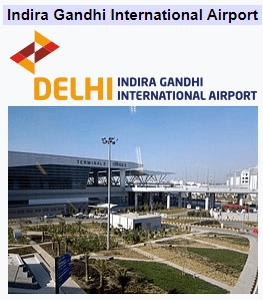

Airlines and destinations
Passenger
| Aeroflot | Moscow–Sheremetyevo | |
| Air Arabia | Sharjah | |
| Air Astana | Almaty | |
| Air Canada | Toronto–Pearson, Vancouver | |
| Air China | Beijing–Capital | |
| Air France | Paris–Charles de Gaulle | |
| Air India | Ahmedabad, Amritsar, Aurangabad, Bagdogra, Bahrain, Bangalore, Bangkok–Suvarnabhumi, Bhopal, Bhubaneswar, Birmingham, Chandigarh, Chennai, Chicago–O’Hare, Coimbatore, Colombo–Bandaranaike, Copenhagen, Dammam, Doha, Dubai–International, Durgapur, Frankfurt, Gaya, Goa, Guwahati, Hong Kong, Hyderabad, Imphal, Indore, Jaipur, Jammu, Jeddah, Jodhpur, Kabul, Kannur, Kathmandu, Khajuraho, Kochi, Kolkata, Kozhikode, Leh, London–Heathrow, Lucknow, Madrid, Malé, Melbourne, Milan–Malpensa, Mumbai, Muscat, Nagpur, Najaf, Nanded, New York–JFK, Newark, Paris–Charles de Gaulle, Patna, Port Blair, Pune, Raipur, Rajkot, Ranchi, Riyadh, Rome–Fiumicino, San Francisco, Seoul–Incheon, Shanghai–Pudong, Singapore, Srinagar, Stockholm–Arlanda, Surat, Sydney, Tel Aviv, Thiruvananthapuram, Tirupati, Tokyo–Narita, Toronto–Pearson, Udaipur, Vadodara, Varanasi, Vienna, Vijayawada, Visakhapatnam, Washington–Dulles, Yangon | |
| Air India Express | Abu Dhabi, Coimbatore, Dubai–International, Madurai, Tiruchirappalli | |
| Air Mauritius | Mauritius | |
| AirAsia India | Ahmedabad, Bagdogra, Bangalore, Chandigarh, Chennai, Goa, Guwahati, Hyderabad, Imphal, Indore, Jaipur, Kochi, Kolkata, Mumbai, Pune, Ranchi, Srinagar | |
| AirAsia X | Kuala Lumpur–International | |
| Alitalia | Rome–Fiumicino | |
| Alliance Air | Amritsar, Allahabad, Bathinda, Bikaner, Chandigarh, Dehradun, Dharamshala, Gorakhpur, Gwalior, Indore, Jabalpur, Jaipur, Jammu, Kullu, Ludhiana, Pantnagar, Pathankot, Shimla | |
| All Nippon Airways | Tokyo–Haneda | |
| Ariana Afghan Airlines | Herat, Kabul, Kandahar | |
| Avia Traffic Company | Bishkek | |
| Bhutan Airlines | Kathmandu, Paro | |
| Biman Bangladesh Airlines | Dhaka | |
| British Airways | London–Heathrow | |
| Cathay Pacific | Hong Kong | |
| China Airlines | Taipei–Taoyuan | |
| China Eastern Airlines | Beijing-Capital, Shanghai–Pudong | |
| China Southern Airlines | Guangzhou, Sanya | |
| Druk Air | Dubai–International (begins 4 September 2020), Kathmandu, Paro | |
| Emirates | Dubai–International | |
| Ethiopian Airlines | Addis Ababa | |
| Etihad Airways | Abu Dhabi | |
| Finnair | Helsinki | |
| flydubai | Dubai–International | |
| Flynas | Riyadh | |
| GoAir | Abu Dhabi, Ahmedabad, Aizawl, Bagdogra, Bangalore, Bangkok–Suvarnabhumi, Chandigarh, Colombo–Bandaranaike, Goa, Guwahati, Hyderabad, Indore, Jammu, Kochi, Kolkata, Leh, Lucknow, Mumbai, Nagpur, Patna, Phuket, Port Blair, Pune, Ranchi, Srinagar, Varanasi Seasonal: Malé | |
| Gulf Air | Bahrain | |
| IndiGo | Abu Dhabi, Agartala, Ahmedabad, Allahabad, Amritsar, Aurangabad, Bagdogra, Bangalore, Bangkok–Suvarnabhumi , Bhopal, Bhubaneswar, Chandigarh, Chengdu, Chennai, Coimbatore, Dammam, Dehradun, Dhaka, Dibrugarh, Dimapur, Doha, Dubai–International, Goa, Gorakhpur, Guwahati, Hyderabad, Imphal, Indore, Istanbul, Jabalpur , Jaipur, Jammu, Jeddah, Jodhpur, Jorhat, Kathmandu, Kochi, Kolkata, Kozhikode, Kuala Lumpur–International, Kuwait, Lucknow, Mumbai, Nagpur, Patna, Phuket, Port Blair, Pune, Raipur, Ranchi, Riyadh, Shirdi, Singapore, Srinagar, Surat, Thiruvananthapuram, Udaipur, Vadodara, Varanasi, Visakhapatnam | |
| Iraqi Airways | Baghdad, Basra | |
| Japan Airlines | Tokyo–Haneda | |
| Jazeera Airways | Kuwait | |
| Kam Air | Kabul, Mazar-i-Sharif | |
| KLM | Amsterdam | |
| Korean Air | Seoul–Incheon | |
| Kuwait Airways | Kuwait | |
| LOT Polish Airlines | Warsaw–Chopin | |
| Lufthansa | Frankfurt, Munich | |
| Mahan Air | Mashhad, Tehran–Imam Khomeini | |
| Malaysia Airlines | Kuala Lumpur–International | |
| Malindo Air | Kuala Lumpur–International | |
| Nepal Airlines | Kathmandu | |
| NokScoot | Bangkok–Don Mueang | |
| Oman Air | Muscat | |
| Qatar Airways | Doha | |
| Saudia | Jeddah, Riyadh Hajj: Medina | |
| Shandong Airlines | Jinan, Kunming, Qingdao | |
| Singapore Airlines | Singapore | |
| Somon Air | Dushanbe | |
| SpiceJet | Adampur, Ahmedabad, Aurangabad, Bagdogra, Bangalore, Bangkok–Suvarnabhumi, Bhopal, Chennai, Dehradun, Dharamshala, Dhaka, Dubai–International, Durgapur, Goa, Gorakhpur, Guwahati, Hong Kong, Hyderabad, Jabalpur, Jaipur, Jammu, Jeddah, Jharsuguda, Kabul, Kanpur, Kishangarh, Kochi, Kolkata, Leh, Madurai, Mangalore, Mumbai, Patna, Port Blair, Pune, Shirdi, Silchar, Srinagar, Surat, Thiruvananthapuram, Udaipur, Varanasi Seasonal: Allahabad, Jaisalmer, Jodhpur | |
| SriLankan Airlines | Colombo–Bandaranaike | |
| Swiss International Air Lines | Zurich | |
| Thai Airways | Bangkok–Suvarnabhumi | |
| Turkish Airlines | Istanbul | |
| Turkmenistan Airlines | Ashgabat | |
| Ukraine International Airlines | Kiev–Boryspil | |
| United Airlines | Newark (resumes July 6, 2020), San Francisco (resumes July 6, 2020) | |
| Uzbekistan Airways | Tashkent | |
| VietJet Air | Da Nang (begins 14 May 2020), Hanoi, Ho Chi Minh City | |
| Virgin Atlantic | London–Heathrow | |
| Vistara | Ahmedabad, Amritsar, Bagdogra, Bangalore, Bangkok–Suvarnabhumi, Bhubaneswar, Chandigarh, Chennai, Colombo–Bandaranaike, Dehradun, Dibrugarh, Goa, Guwahati, Hyderabad, Indore, Jammu, Jodhpur, Kathmandu, Kochi, Kolkata, Leh, Lucknow, Mumbai, Patna, Port Blair, Pune, Ranchi, Raipur, Singapore, Srinagar, Thiruvananthapuram, Udaipur, Varanasi | |
| Zoom Air | Agra, Jaisalmer |
Cargo
| ASL Airlines Belgium | Dubai–International, Liege | |
| Bismillah Airlines | Dhaka | |
| Blue Dart Aviation | Ahmedabad, Aurangabad, Bagdogra, Bangalore, Bhopal, Chennai, Cochin, Coimbatore, Goa, Hyderabad, Indore, Jaipur, Kolkata, Lucknow, Mumbai, Nagpur, Raipur, Ranchi, Patna, Thiruvananthapuram | |
| Cathay Pacific Cargo | Bangalore, Hong Kong, Hyderabad, Kolkata, London–Heathrow, Manchester, Milan–Malpensa, Paris–Charles de Gaulle | |
| China Airlines Cargo | Luxembourg, Taipei–Taoyuan | |
| DHL Aviation | Hong Kong, Leipzig/Halle | |
| Ethiopian Airlines Cargo | Chongqing, Addis Ababa | |
| FedEx Express | Chengdu, Dubai–International, Guangzhou, Memphis | |
| Kalitta Air | Hong Kong, Leipzig/Halle | |
| Korean Air Cargo | Hanoi, Seoul–Incheon, Vienna | |
| Lufthansa Cargo | Frankfurt, Dhaka, Guangzhou, Krasnoyarsk | |
| MASkargo | Kuala Lumpur–International, Chennai | |
| Qatar Airways Cargo | Doha | |
| Quikjet Airlines | Bangalore, Chennai, Hyderabad, Mumbai | |
| SF Airlines | Shenzhen | |
| SpiceXpress | Bangalore, Hanoi | |
| Thai Cargo | Bangkok–Suvarnabhumi | |
| Turkish Airlines Cargo | Hanoi, Istanbul–Atatürk | |
| UPS Airlines | Bangkok, Cologne, Dubai | |
| Uzbekistan Airways | Navoi |
Connectivity
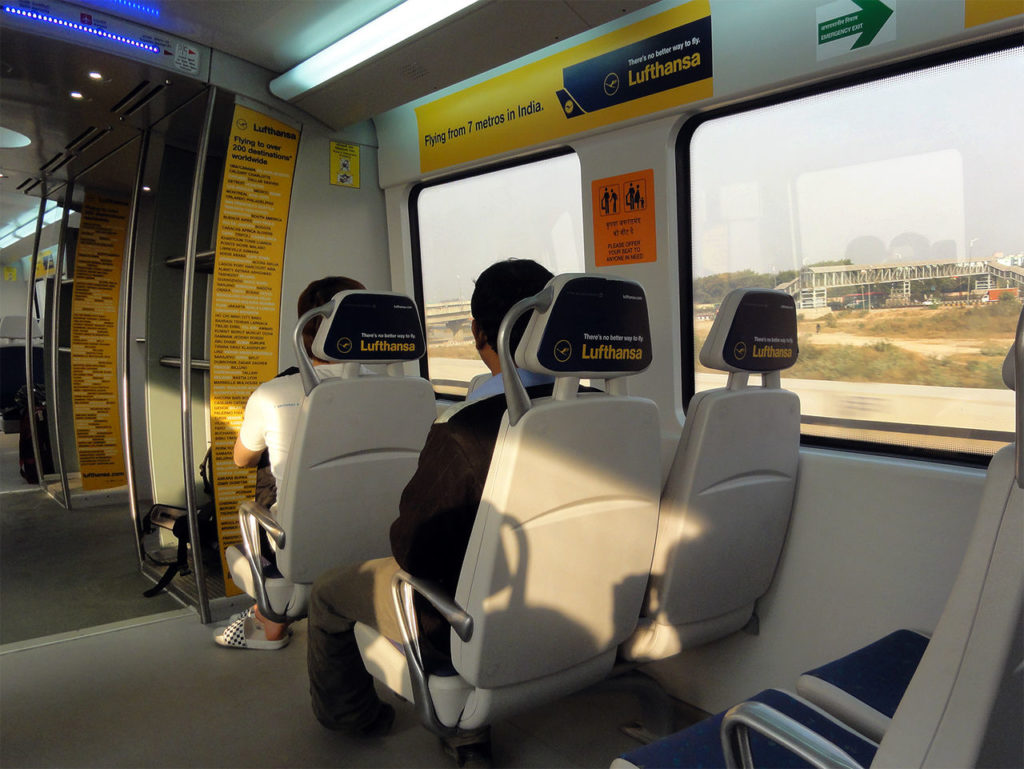

Source: Craigdietrich
Rail
The nearest railway station is the Palam railway station, located 4.8 kilometres (3.0 mi) and 12 kilometres (7.5 mi) from terminals 1 and 3 respectively. Several passenger trains run regularly between these stations. Shahabad Mohammadpur (SMDP) is equally close.
Terminals 2 and 3 of the airport are served by the Airport metro station on Delhi Airport Metro Express line. The 22.7 km (14.1 mi) line runs from Dwarka Sector 21 to the New Delhi metro station with trains running every 10 minutes. Terminal 1 is served by the Terminal 1-IGI Airport metro station on the Magenta Line.
Road
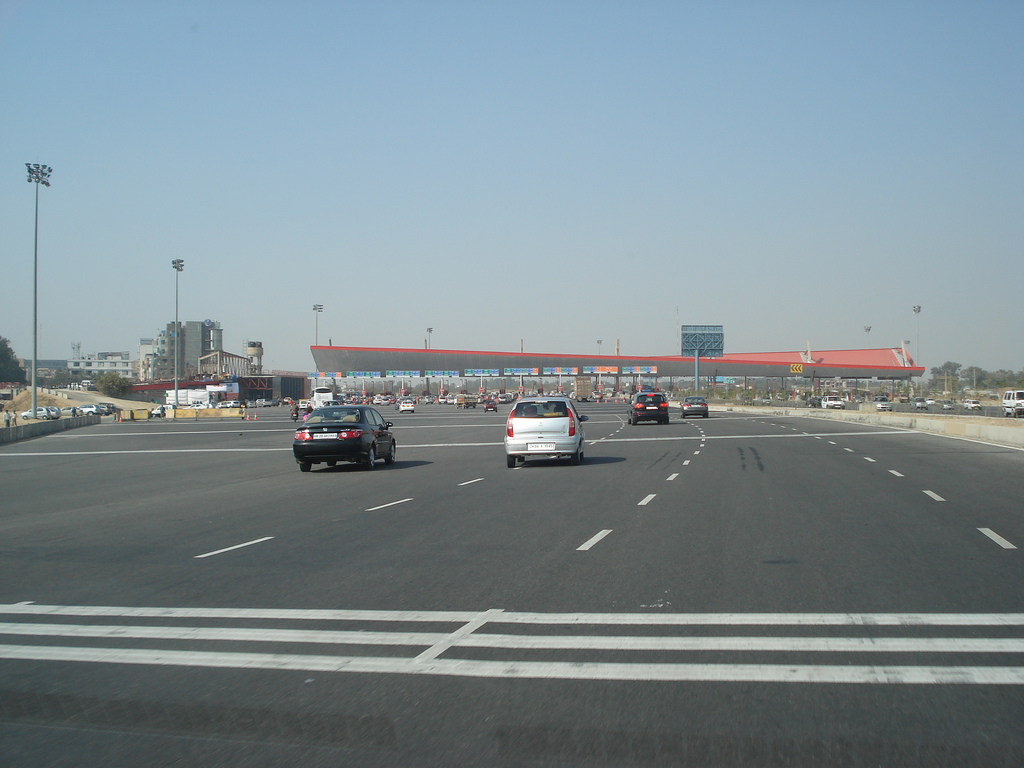

Source: https://www.flickr.com/photos/gurgaonshoppingmalls/2223804742/
The airport is connected by the 8-lane Delhi Gurgaon Expressway. Air conditioned low-floor buses operated by Delhi Transport Corporation (DTC) regularly run between the airport and the city. Metered taxis are also available from terminals T3 and T1C to all areas of Delhi.
Future Expansion
Terminals 4, 5 and 6 will be built at a later stage, which will be triggered by growth in traffic. Once completed, all international flights will move to these three new terminals. Terminal 3 will then be solely used for handling domestic air traffic. A new cargo handling building is also planned. According to Delhi International Airport Limited (DIAL), these new terminals will increase the airport’s annual passenger volume capacity to 100 million.
DIAL submitted a plan in 2016 to the then aviation secretary R N Choubey regarding expansion of the airport with a new fourth runway and Terminal 4 in a phased manner. The Master Plan of Airport in 2016 was then reviewed and updated by DIAL in consultation with the Airports Authority of India. The terminal construction will start after the fourth runway is completed and expansion of terminals 1 and 3.
Accidents and Incidents
1970
A Royal Nepal Airlines Fokker F27-200 (9N-AAR) after a flight from Kathmandu, Nepal was caught in severe thunderstorms with turbulence and downdrafts on final approach to Palam Airport. The pilot lost control of the aircraft and crashed short of the runway. Of the five crew and 18 passengers, one crew member was killed.
1972
Japan Airlines Flight 471 crashed outside of Palam Airport, killing 82 of 87 occupants; ten of eleven crew members and 72 of 76 passengers died, as did three people on the ground.
1973
Indian Airlines Flight 440 crashed while on approach to Palam Airport, killing 48 of the 65 passengers and crew on board.
1990
An Air India Boeing 747 flying on the London-Delhi-Mumbai route and carrying 215 people (195 passengers and 20 crew) touched down at Indira Gandhi International Airport after a flight from London Heathrow Airport. On application of reverse thrust, a failure of the no. 1 engine pylon to wing attachment caused this engine to tilt nose down. Hot exhaust gases caused a fire on the left wing. There were no casualties but the aircraft was damaged beyond repair and written off.
1995
Indian Airlines Flight 492 (IC 492), A Boeing 737-2A8 (Registered VT-ECS), damaged beyond repair when the aircraft overshot the runway at Delhi airport due to pilots error, on its scheduled flight from Jaipur to Delhi.
1996
The airport was involved in the Charkhi Dadri mid-air collision when a Saudia Boeing 747-100B, climbing out after take-off, collided with an incoming Kazakhstan Airlines Ilyushin Il-76 chartered by a fashion company, causing the deaths of all 349 people on board the two planes.
Source: wikipedia
